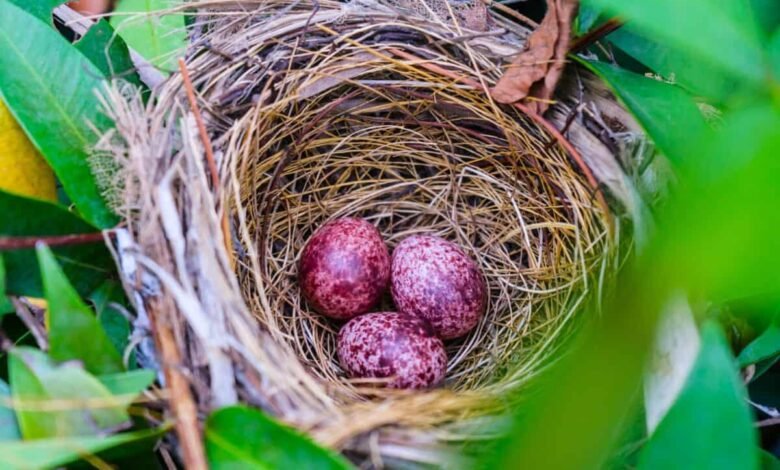Cardinal Eggs: Everything You Need to Know About These Bright Red Wonders

Cardinal eggs are small, bright red eggs laid by the beautiful Northern Cardinal, one of the most beloved birds in North America. Cardinal eggs are not only eye-catching but also hold a fascinating story of nature, care, and survival. These eggs usually appear in a soft greenish or bluish color with tiny speckles, but the most iconic and noticeable ones are the red-tinted eggs you might spot in spring. Many people wonder about the life inside these tiny eggs, from the moment the mother cardinal lays them to the day the little chicks hatch. Observing cardinal eggs is a great way to learn about bird behavior, nesting habits, and the important role these birds play in our gardens and local ecosystems. They are a symbol of spring, renewal, and the magic of wildlife close to our homes.
Cardinal eggs are laid in well-hidden nests, usually placed in thick shrubs or low tree branches, making them tricky to spot for predators and humans alike. A female cardinal typically lays three to five eggs during a single breeding season. Each egg is carefully incubated by the mother for about 12 to 13 days, a time when she rarely leaves the nest to ensure the warmth and protection of her future chicks. The eggs are delicate, and the process of hatching is remarkable, as tiny chicks emerge with bright eyes and soft down feathers, ready to be fed by both parents. Watching cardinal eggs develop into fully grown birds teaches patience, appreciation for nature, and respect for wildlife. If you are lucky enough to see cardinal eggs, it is important to observe from a distance, so the parents are not disturbed. These eggs are not just a part of a bird’s life cycle—they are a glimpse into the secret world of birds thriving right outside our windows.
How to Identify Cardinal Eggs in Your Garden
Cardinal eggs are small and usually pale green or bluish with tiny brown speckles, but sometimes they look a little reddish. You can find them in thick shrubs, small trees, or low branches where the mother cardinal feels safe. The nest is often hidden, so you need to look carefully and quietly. Female cardinals build the nest with twigs, grass, and leaves. The eggs are smooth and oval-shaped, about the size of a jellybean. If you see a mother cardinal sitting in the nest, she is probably incubating eggs. Watching from a distance is best so you do not scare her. Knowing what cardinal eggs look like helps bird watchers and nature lovers understand the life of cardinals and enjoy the beauty of spring. Observing without touching keeps the eggs safe and lets nature work as it should.
The Life Cycle of Cardinal Eggs: From Nest to Flight
Cardinal eggs start a journey that lasts about two weeks before hatching. The mother sits on the eggs almost all the time to keep them warm, and the father brings food for her. After 12 to 13 days, tiny chicks hatch, blind and featherless, needing care from both parents. The chicks grow fast, gaining feathers and learning to hop and fly. After about 9 to 11 days, they leave the nest but still depend on their parents for food and safety. Watching this life cycle teaches us how birds care for their young and survive in the wild. It is amazing to see how small eggs turn into strong birds ready to explore the world.
Cardinal Eggs vs Other Bird Eggs: Key Differences
fastest bird in the world are smaller than many other bird eggs and have a unique color pattern. While robin eggs are bright blue and sparrows have plain light-colored eggs, cardinal eggs can be pale green, bluish, or red-tinted with speckles. The nests are also different; cardinals prefer dense shrubs or low branches, while other birds may choose trees or open areas. Cardinal eggs usually hatch in 12 to 13 days, which is shorter than some larger birds. Learning these differences helps bird watchers know which bird is in their garden and how to protect the eggs. Each bird species has its special way of nesting and caring for eggs, making the study of cardinal eggs an exciting adventure for nature lovers and beginners alike.
Tips for Protecting Cardinal Eggs from Predators
To keep cardinal eggs safe, it is important not to touch the nest or move the eggs. Predators like squirrels, snakes, or other birds can spot eggs easily, so hiding the nest with extra shrubs or plants can help. Watching from a distance is safer for the birds, and using bird-friendly feeders nearby gives adult cardinals extra food, which helps them protect their nest. Keeping pets away from nesting areas also reduces stress for the mother. Even simple steps like planting thick bushes or leaving some natural cover can make a big difference. Protecting eggs helps more baby cardinals survive and keeps your garden full of birds each spring.
What Colors Are Cardinal Eggs and Why?
Cardinal eggs come in soft green, bluish, or red-tinted colors with tiny brown speckles. These colors help hide the eggs in the nest so predators do not see them easily. The mother cardinal’s feathers also help cover the eggs while she sits on them. Red-tinted eggs are less common but very beautiful. The color is natural and shows how birds adapt to their environment to protect their young. Watching these colors is fun and helps you understand why birds choose certain places to build nests. Learning about egg colors gives a closer look at nature and the care that mother cardinals give to their babies.
Fun Facts About Cardinal Eggs You Might Not Know
Cardinal eggs are amazing because each one is unique in size, shape, and color. Some cardinals may lay three eggs, while others lay five in a season. The eggs hatch faster than many other birds, and both parents help feed the chicks. Baby cardinals grow quickly and leave the nest in less than two weeks. Cardinals often return to the same area every year to lay eggs in familiar spots. Learning fun facts about these eggs helps us appreciate nature and encourages kids and adults to watch birds without disturbing them. Cardinal eggs show how strong and caring these birds are in the wild.
How to Photograph Cardinal Eggs Safely
Photographing cardinal eggs can be exciting but requires care. Always use a zoom lens to avoid getting close and scaring the birds. Never touch the eggs or the nest, and try to take pictures in the early morning or late afternoon when the light is soft. Make sure you stay hidden and quiet so the mother cardinal does not fly away. Taking photos safely lets you enjoy the beauty of cardinal eggs without harming them. Sharing these pictures can help others learn about cardinals and nature while keeping the eggs safe. Patience and respect make the best wildlife photography.
Seasonal Guide: When to Expect Cardinal Eggs in the Wild
Cardinals usually lay eggs in spring, often from March to July. The first clutch may have three to five eggs, and a second clutch can follow in the same season. The timing depends on weather, food availability, and habitat safety. Spring is the best time to watch nests and see eggs hatch. Fall and winter are when cardinals focus on finding food and staying safe, not laying eggs. Knowing the seasonal schedule helps bird watchers plan when to observe without disturbing the birds. Expecting eggs at the right time allows for safe observation and increases the chances of seeing chicks grow and leave the nest.
Conclusion
Watching cardinal eggs is a special experience that shows the beauty of nature up close. These small eggs carry tiny lives that grow into bright red cardinals, filling gardens with color and song. Observing them teaches patience and care for animals.
Protecting cardinal eggs is very important. By staying quiet and not touching the nests, we help birds survive and enjoy spring. Learning about cardinal eggs can make anyone a little nature expert and gives happiness to those who love watching birds.
FAQs
Q: What do cardinal eggs look like?
A: They are small, pale green, bluish, or red-tinted with tiny brown speckles.
Q: How many eggs do cardinals lay?
A: Usually three to five eggs per clutch in a breeding season.
Q: How long do cardinal eggs take to hatch?
A: About 12 to 13 days of incubation by the mother.
Q: Can I touch cardinal eggs?
A: No, touching eggs can harm them and scare the mother bird.
Q: Where do cardinals build their nests?
A: In thick shrubs, low trees, or hidden branches for safety.




